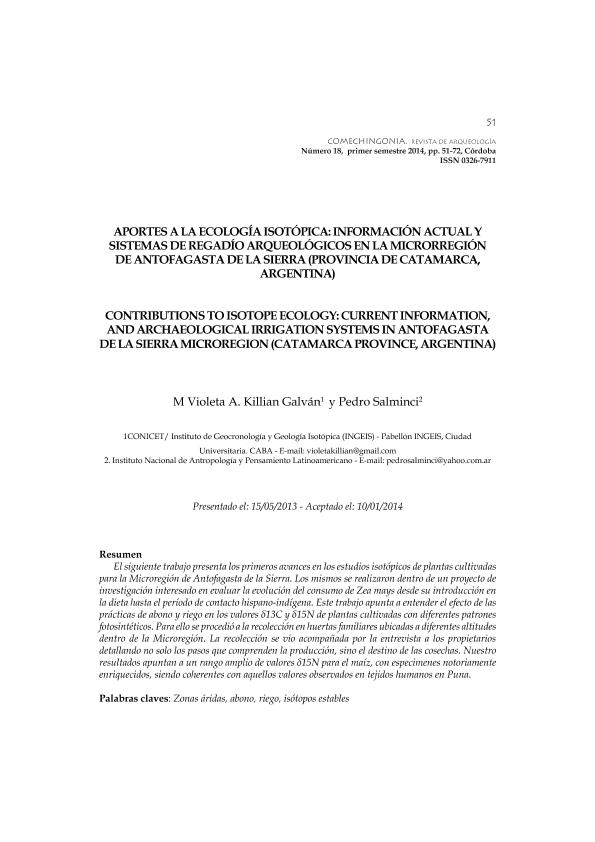Artículo
El siguiente trabajo presenta los primeros avances en los estudios isotópicos de plantas cultivadas para la Microregión de Antofagasta de la Sierra. Los mismos se realizaron dentro de un proyecto de investigación interesado en evaluar la evolución del consumo de Zea mays desde su introducción en la dieta hasta el período de contacto hispano-indígena. Este trabajo apunta a entender el efecto de las prácticas de abono y riego en los valores δ13C y δ15N de plantas cultivadas con diferentes patrones fotosintéticos. Para ello se procedió a la recolección en huertas familiares ubicadas a diferentes altitudes dentro de la Microregión. La recolección se vio acompañada por la entrevista a los propietarios detallando no solo los pasos que comprenden la producción, sino el destino de las cosechas. Nuestro resultados apuntan a un rango amplio de valores δ15N para el maíz, con especimenes notoriamente enriquecidos, siendo coherentes con aquellos valores observados en tejidos humanos en Puna. This paper shows the first advances in isotopic studies of cultivated plants for the micro region of Antofagasta de la Sierra. They were performed within a research project interested in assessing the evolution of Zea mays consumption since its introduction in diet until the Spanish contact. The aim of this paper is oriented to understand the effects of fertilizers and irrigation practices in δ13C and δ15N values of cultivated plants with different photosynthetic pathways. In order to do this, we have harvested specimens from family farms located at different altitudes within the microregion. The collection was accompanied by an interview with the owners of the fields detailing not only the steps that comprise the production, but the destination of the crops. This study have allowed to generate new hypotheses about the importance of plant as a component of the Puna´s diets and how they could have become relevant during periods of increased agricultural intensification and extensification. Our results point to a wide range of δ15N values in maize, with markedly enriched specimens, being coherent with those values seen in human tissues from Puna.
Aportes a la ecología isotópica: información actual y sistemas de regadío arqueológicos en la microrregión de Antofagasta de la Sierra (provincia de Catamarca, Argentina)
Título:
Contributions to isotope ecology: current information, and archaeological irrigation systems in Antofagasta de la Sierra microregion (Catamarca province, Argentina)
Fecha de publicación:
07/2014
Editorial:
Consejo Nacional de Investigaciones Científicas y Técnicas. Centro de Estudios Históricos "Prof. Carlos S. A. Segreti"
Revista:
Comechingonia
ISSN:
0326-7911
e-ISSN:
2250 - 7728
Idioma:
Español
Tipo de recurso:
Artículo publicado
Clasificación temática:
Resumen
Palabras clave:
Zonas Áridas
,
Fertilizantes
,
Irrigación
,
Isótopos Estables
Archivos asociados
Licencia
Identificadores
Colecciones
Articulos(INGEIS)
Articulos de INST.DE GEOCRONOLOGIA Y GEOLOGIA ISOTOPICA (I)
Articulos de INST.DE GEOCRONOLOGIA Y GEOLOGIA ISOTOPICA (I)
Citación
Killian Galván, Violeta Anahí; Salminci, Pedro Miguel; Aportes a la ecología isotópica: información actual y sistemas de regadío arqueológicos en la microrregión de Antofagasta de la Sierra (provincia de Catamarca, Argentina); Consejo Nacional de Investigaciones Científicas y Técnicas. Centro de Estudios Históricos "Prof. Carlos S. A. Segreti"; Comechingonia; 18; 1; 7-2014; 51-72
Compartir




